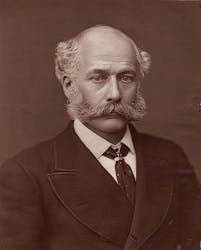Take an interactive tour of Bazalgette’s handmade sewers of London
LONDON, England – Ever wondered how a city the size of London overcame enormous sanitation problems back in the mid-1800s?
Well now, thanks to an interactive slide slow from the Guardian, you can find out the history behind London’s chronic cholera problems and how one man spearheaded a wastewater revolution.
You can take the interactive tour here.
It was in 1858 that London had had enough of cholera outbreaks and the stench of wastewater being poured into the local environment.
Civil engineer Joseph Bazalgette (pictured below) won the bid to build London’s sewers, proposing a system that comprised 1,100 miles of street sewers and 82 miles of main sewers, to be built using 318 million bricks.
The tour quotes Medical historian Richard Barnett as saying: “One of the most striking things about Bazalgette’s sewerage system is that in a sense it’s all handmade. This isn’t a mass-produced sewerage system, this is something that’s been very carefully planned and then carefully constructed by skilled artisans.”
Seven years later, it was in 1865 when the Prince of Wales opened the sewer network.
However, despite changing London’s fortunes, enabling it to grow into an economic powerhouse, the system has reached capacity and become antiquated.
The new system – known as the Thames Tideway – is being built in order to help upgrade the capitals sewer network.
Tidway will be the biggest infrastructure project ever undertaken by the UK water industry, which will see 25km of tunnels constructed beneath London.
###
Read more
London ‘super sewer’ secures £700m loan from European Investment Bank
Mott Macdonald designing Tideway’s East tunnel section of London super sewer


